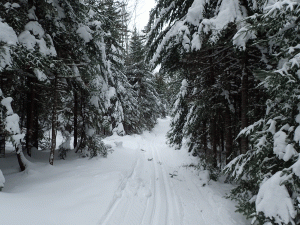Maine’s forests are outstanding in so many respects – the economic opportunities they provide in the wood products and outdoor recreation sectors, the foundation for healthy fish and wildlife habitat and clean water, the cultural and historic values they hold, and their ability to refresh our lives with beauty and a sense of grandeur.

Maine’s forests also store, or sequester, carbon and lots of it. Why should we care that Maine’s forests store large amounts of carbon? Carbon sequestration in forests helps to offset increasing concentrations of carbon dioxide (CO2) in the atmosphere such as occurs from forest conversion to other land uses, forest fires, and from other sources of human activity such as fossil fuel combustion. Trees and plants take up CO2 from the atmosphere through photosynthesis and store it as carbon in their trunks, branches, foliage, and roots. Utilizing wood for construction and other durable materials also represents an enormous contribution to carbon storage.
Maine is known as the most heavily forested state in the United States with approximately 17.5 million acres of forestland. The trees in Maine’s forests store hundreds of millions of metric tons of carbon in just the portions of the trees that are above ground. Much more carbon is stored in the stumps and roots. And lots more carbon is stored in the forest soil. To understand the significance of these numbers, it is currently estimated that 50% or more of Maine’s total CO2 emissions are being stored by Maine’s forests each year.
The Forest Society of Maine is proud to work with forest landowners, conservation partners and, with your help, to implement permanent conservation solutions that keep Maine’s forests as forests–storing carbon in the trees, soils, and wood products far into the future.
-Karin Tilberg
Published in FSM’s biannual newsletter, Forest View, fall 2019 edition.
